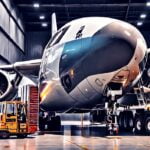Discover the significant benefits of water transport and explore the cost-effective and eco-friendly solutions it offers. With over a decade of experience in logistics and freight management, our team understands the advantages that water transport brings to the table. As seasoned professionals, we have witnessed the seamless operations and maximized efficiency that can be achieved by harnessing the power of water transport. Join us as we delve into the world of optimized freight movement, market trends analysis, and multimodal logistics coordination, and unveil the undeniable advantages of water transport.
Key Takeaways:
– Water transport is cost-effective for long-distance travel, especially for heavy goods.
– It is an eco-friendly mode of transportation with reduced pollution compared to other modes.
– Water transport has low maintenance costs and requires minimal infrastructure.
– It is efficient for moving cars or luggage as they can be directly loaded onto boats.
Advantages of Water Transport

Water transport offers numerous advantages that make it a cost-effective and eco-friendly solution for freight movement. By leveraging the natural properties of water, businesses can optimize their supply chain operations while minimizing their environmental impact. Let’s explore the key advantages of water transport in more detail.
Cost-Effectiveness: Saving Money on Long-Distance Travel
One of the primary advantages of water transport is its cost-effectiveness, especially for long-distance travel. Compared to other modes of transportation, such as road or air, traveling by boat is relatively inexpensive, making it an ideal choice for the transportation of heavy goods. The bulk carrying capacity of water vessels allows for economies of scale, enabling businesses to transport large quantities of freight at a lower cost per unit. This affordability is particularly beneficial for businesses that need to move goods over vast distances.
Eco-Friendly Nature: Contributing to Environmental Conservation
Water transport is inherently eco-friendly, making it a sustainable option for businesses looking to reduce their carbon footprint. Unlike other modes of transportation, such as road or air, which release significant amounts of greenhouse gases, water transport causes minimal pollution. By harnessing the power of water currents and wind, boats can travel with reduced fuel consumption and emissions, resulting in cleaner air and water. This environmentally conscious approach aligns with the growing demand for sustainable solutions in the logistics industry and contributes to the preservation of our planet.
Low Maintenance Costs and Infrastructure Requirements
Another advantage of water transport is its affordability in terms of maintenance costs and infrastructure requirements. Compared to other modes of transportation, boats have relatively low maintenance needs. Additionally, waterways already exist naturally, eliminating the need for extensive infrastructure development. Ports and harbors serve as hubs where goods are loaded and unloaded efficiently, reducing operational costs. This cost-efficient nature makes water transport an attractive option for businesses seeking economical freight solutions.
Efficient Movement of Goods: Direct Loading onto Boats
Water transport offers significant benefits in terms of moving goods efficiently. Unlike other modes of transportation that involve multiple handling and transshipment processes, such as loading goods onto trucks or airplanes, water transport enables direct loading onto boats. This streamlined process minimizes the risk of damage and loss, ensuring the safe transportation of goods. Furthermore, boats have the capacity to transport a wide range of goods, from cars to luggage, making them versatile for various types of cargo.
To summarize, the advantages of water transport include its cost-effectiveness, eco-friendly nature, low maintenance costs, and efficient movement of goods. By considering these advantages, businesses can leverage water transport to optimize their supply chain operations, reduce costs, and contribute to environmental conservation. Embracing this sustainable mode of transportation is not only economically viable but also aligns with the growing need for eco-friendly solutions in the logistics industry. So why not explore the vast advantages of water transport and embark on a journey towards greener and more efficient freight movement?
Keywords: [advantages of water transport]
There are numerous advantages of a traffic light control system. To learn more, click here and discover how this system can efficiently manage traffic flow and enhance road safety.
If you’re interested in the benefits of a traffic management system, you’ll certainly want to check out this link: advantages of traffic management system. Find out how this system optimizes traffic operations and improves overall transportation efficiency.
Discover the advantages of a well-designed transport system by clicking here. This link provides valuable insights into how an efficient transport system can enhance economic growth, reduce congestion, and improve connectivity.
Water transport offers unique advantages that you may not be aware of. Click here to explore the advantages of using sea transport and discover how it enables efficient trade, reduces carbon emissions, and unlocks new opportunities.
If you’re curious about the advantages of using water transport, this link is a must-read: advantages of using water transport. Uncover the benefits of utilizing waterways for transportation, including cost-effectiveness, environmental sustainability, and accessibility.
Looking to understand the benefits of a water transport system? Click here and explore the advantages it offers, such as efficient movement of goods, reduced congestion on highways, and minimized environmental impact.
Environmental Benefits of Water Transport

Water transport offers numerous environmental benefits that make it a sustainable and eco-friendly mode of transportation. From reducing greenhouse gas emissions to minimizing infrastructure requirements, the environmental advantages of water transport are significant. In this article, we will explore these benefits and understand how water transport contributes to environmental conservation.
Reduction in Greenhouse Gas Emissions
Transportation is a major contributor to carbon dioxide emissions and other greenhouse gases that contribute to climate change. However, water transport stands out as an environmentally friendly alternative. Water transport produces fewer greenhouse gas emissions and has a lower carbon footprint compared to road and air transport. Ships and barges, which are commonly used in water transport, consume less fuel per unit of cargo transported, resulting in reduced emissions.
Conservation of Natural Resources
Water transport plays a crucial role in conserving natural resources. By utilizing watercourses such as rivers, canals, and navigable waterways, it reduces the need for extensive infrastructure development. Unlike road and rail transport, which require the construction of highways and railways, water transport follows natural paths, minimizing the impact on the environment. This reduces the destruction of habitats and preserves the natural beauty of landscapes.
Preservation of Air Quality
Air pollution is a significant concern in urban areas, largely caused by vehicular emissions. With water transport, the reliance on road-based transportation decreases, leading to a reduction in air pollution. By reducing the number of trucks and other vehicles on the roads, water transport helps preserve air quality, making it a cleaner and healthier transportation option.
Prevention of Soil Erosion
Road and rail transport tend to disturb the soil and contribute to erosion, particularly in areas with fragile ecosystems. Water transport, on the other hand, causes minimal disruption to the soil. By relying on waterways, water transport helps prevent soil erosion, preserving the stability of ecosystems and protecting agricultural land.
Efficient Use of Fuel
Large water vessels, such as ships and barges, have the advantage of being able to spread out their fuel expenses more economically than smaller modes of transport. This efficient use of fuel not only results in cost savings but also contributes to environmental conservation. By optimizing fuel consumption, water transport helps reduce the demand for fossil fuels and minimizes the overall carbon footprint.
Conclusion
In conclusion, water transport offers several environmental benefits that cannot be overlooked. From reducing greenhouse gas emissions and conserving natural resources to preserving air quality and preventing soil erosion, the advantages of water transport are clear. Adopting water transport as part of an efficient and sustainable supply chain can contribute significantly to environmental conservation.
Key Takeaways:
- Water transport produces fewer greenhouse gas emissions and has a lower carbon footprint compared to road and air transport.
- By utilizing watercourses, water transport reduces the need for extensive infrastructure development, preserving the environment.
- Water transport helps reduce air pollution by reducing the reliance on road-based transportation.
- Water transport minimizes soil erosion and preserves the stability of ecosystems.
- The efficient use of fuel in water transport contributes to environmental conservation.
SOURCES:
– Byju’s – Advantages and Disadvantages of Water Transport
– Aplustopper – Advantages and Disadvantages of Water Transportation
Capacity and Scalability of Water Transport
Water transportation offers numerous advantages, including its capacity and scalability for transporting goods. In this article, we will explore the key benefits of water transport in terms of its capacity to handle large quantities of goods and its scalability for efficient freight movement.
Advantages of Capacity in Water Transport
Water transport has the remarkable capability to carry heavy and bulky goods, making it an excellent choice for transporting goods on a large scale. Ships and water vessels are designed to accommodate substantial amounts of cargo, allowing businesses to transport goods efficiently and cost-effectively.
The capacity of water transport is particularly advantageous when it comes to carrying weighty and mass cargoes. Ships and barges have the space and strength to handle substantial loads, enabling businesses to transport significant amounts of goods in a single trip. This reduces the need for multiple shipments and minimizes operational costs.
Moreover, water transport is known for being the least expensive type of transportation for long-distance journeys. The fuel expenses of large vessels can be spread out more economically, resulting in lower overall costs for businesses and consumers. This affordability and cost-effectiveness make water transport a highly attractive option for businesses seeking to optimize their freight movement.
Scalability in Water Transport
In addition to its impressive capacity, water transport also offers scalability advantages that contribute to enhanced operational efficiency. The scalability of water transport refers to its ability to adapt and accommodate varying demands for transportation.
Water transport can efficiently handle fluctuations in demand by adjusting the number of vessels deployed or the frequency of shipments. For example, during peak seasons or periods of high demand, additional ships can be deployed to meet the increased transportation needs. This scalability allows businesses to maintain a smooth and uninterrupted supply chain, ensuring timely delivery of goods.
The scalability of water transport is particularly beneficial for industries that experience seasonal variations in demand, such as agriculture or retail. By leveraging water transport’s scalability, businesses can optimize their logistics operations and effectively manage variances in transportation requirements.
Key Takeaways:
- Water transport has high capacity, allowing it to carry large quantities of goods efficiently and cost-effectively.
- The capacity of water transport enables the transportation of heavy and bulky cargoes that may not be suitable for other modes of transport.
- Water transport is the least expensive type of transportation for long-distance journeys, providing cost savings for businesses and consumers.
- Water transport offers scalability, allowing for the adjustment of transportation volume to meet varying demand.
- The scalability of water transport is advantageous for industries with seasonal variations in transportation requirements.
Sources:
– byjus.com
– aplustopper.com
Importance of Water Transport in Global Trade
Water transport plays a crucial role in global trade, offering numerous advantages and contributing to the economic growth and efficiency of supply chains. Here are some key points highlighting the significance of water transport in global trade:
-
Foreign trade dependence: Water transport is essential for foreign trade, particularly for countries heavily reliant on imports and exports. Countries like India heavily rely on water transportation for the movement of goods, as ports serve as vital gateways for international trade. The efficiency and effectiveness of water transport are crucial for a nation’s economic growth and competitiveness in global trade[^3].
-
Logistical advantages: Water transport provides significant logistical advantages that benefit various sectors of the economy. From cargo ships carrying goods across oceans to tugboats maneuvering vessels in ports, water transport plays a crucial role in global supply chains. It enables the movement of goods on a large scale, meeting the demands of international markets. The cost-effectiveness and reliability of water transportation make it an essential component of the logistics and transportation industry[^4].
In conclusion, water transport holds immense importance in global trade due to its cost-effectiveness, eco-friendliness, reliability, and accessibility to remote areas. It serves as a vital mode of transport for foreign trade and plays a crucial role in driving economic growth and facilitating the movement of goods on a large scale. With its unique advantages, water transport continues to shape and enhance the global trade landscape.
Key Takeaways:
– Water transport is crucial for foreign trade and economic growth.
– It provides logistical advantages for global supply chains.
– The cost-effectiveness and reliability of water transport make it essential for the transportation industry.
Sources:
– Impacts of Water Transport Development on the Economy and Society.
– Water Transport in Transportation and Logistics: Key Considerations.
FAQ
Q1: What are the advantages of water transportation?
A1: Water transportation offers advantages such as cost-effectiveness, high capacity for carrying heavy goods, low maintenance costs, energy efficiency, and environmentally friendly operations.
Q2: How does water transportation compare to other modes of transportation in terms of cost?
A2: Water transportation tends to be less expensive, especially for long distances, compared to rail and road transport. It offers cost savings for businesses and consumers.
Q3: Can water transport accommodate heavy and bulky goods?
A3: Yes, water transport is ideal for carrying heavy goods as it has the capacity to accommodate bulky and weighty cargoes that may not be suitable for other modes of transport.
Q4: What are the environmental benefits of water transportation?
A4: Water transportation is considered environmentally friendly as it produces fewer greenhouse gas emissions and has a lower carbon footprint compared to road and air transport.
Q5: Does water transportation have any limitations?
A5: While water transport has many advantages, it can be slower compared to other modes of transportation, dependent on weather conditions, have limited accessibility to certain inland areas, and require well-developed port infrastructure.
- Unveiling Bernhard Caesar Einstein’s Scientific Achievements: A Legacy in Engineering - July 15, 2025
- Uncover who is Jerry McSorley: CEO, Family Man, Business Success Story - July 15, 2025
- Discover Bernhard Caesar Einstein’s Scientific Contributions: Unveiling a Legacy Beyond Einstein - July 15, 2025















